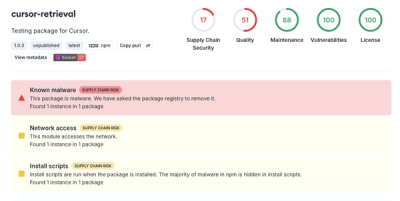
Security News
The Risks of Misguided Research in Supply Chain Security
Snyk's use of malicious npm packages for research raises ethical concerns, highlighting risks in public deployment, data exfiltration, and unauthorized testing.
tldr-lint is a linting tool for validating tldr pages.
It can also format your pages for you!
tldr-lint and its alias tldrl can be installed via npm:
npm install --global tldr-lint
It's really simple.
Usage: tldr-lint [options] <file|dir>
Options:
-V, --version output the version number
-f, --format also attempt formatting (to stdout, or as specified by -o)
-o, --output <file> output to formatted file
-i, --in-place formats in place
-t, --tabular format errors in a tabular format
-v, --verbose print verbose output
-I, --ignore <codes> ignore comma separated tldr-lint error codes (e.g. "TLDR001,TLDR0014")
-h, --help display help for command
We provide a Dockerfile for reproducibly building and testing tldr-lint even without having NodeJS installed.
For building the Docker image, run this command inside the cloned tldr-lint repository:
docker build -t tldr-lint .
For running a tldr-lint container, you need to mount a volume containing the page(s) you want to lint to the container.
For checking a single page, run (replacing {{/path/to/page.md}} with the path to the page you want to check):
docker run --rm -v {{/path/to/page.md}}:/app/page.md tldr-lint page.md
In order to run the container on a directory, mount this directory as follows:
docker run --rm -v {{/path/to/directory}}:/app/pages tldr-lint pages/
[!NOTE] For Windows users, specify the full path to the directory or page you want to check along with the
docker runcommand above.
All of the errors can be found in lib/tldr-lint.js.
| Error Code | Description |
|---|---|
| TLDR001 | File should contain no leading whitespace |
| TLDR002 | A single space should precede a sentence |
| TLDR003 | Descriptions should start with a capital letter |
| TLDR004 | Command descriptions should end in a period |
| TLDR005 | Example descriptions should end in a colon with no trailing characters |
| TLDR006 | Command name and description should be separated by an empty line |
| TLDR007 | Example descriptions should be surrounded by empty lines |
| TLDR008 | File should contain no trailing whitespace |
| TLDR009 | Page should contain a newline at end of file |
| TLDR010 | Only Unix-style line endings allowed |
| TLDR011 | Page never contains more than a single empty line |
| TLDR012 | Page should contain no tabs |
| TLDR013 | Title should be alphanumeric with dashes, underscores or spaces |
| TLDR014 | Page should contain no trailing whitespace |
| TLDR015 | Example descriptions should start with a capital letter |
| TLDR016 | Label for information link should be spelled exactly More information: |
| TLDR017 | Information link should be surrounded with angle brackets |
| TLDR018 | Page should only include a single information link |
| TLDR019 | Page should only include a maximum of 8 examples |
| TLDR020 | Label for additional notes should be spelled exactly Note: (with a succeeding whitespace) |
| TLDR021 | Command example should not begin or end in whitespace |
| TLDR101 | Command description probably not properly annotated |
| TLDR102 | Example description probably not properly annotated |
| TLDR103 | Command example is missing its closing backtick |
| TLDR104 | Example descriptions should prefer infinitive tense (e.g. write) over present (e.g. writes) or gerund (e.g. writing) |
| TLDR105 | There should be only one command per example |
| TLDR106 | Page title should start with a hash (#) |
| TLDR107 | File name should end with .md extension |
| TLDR108 | File name should not contain whitespace |
| TLDR109 | File name should be lowercase |
| TLDR110 | Command example should not be empty |
| TLDR111 | File name should not contain any Windows-forbidden character |
FAQs
A linting tool to validate tldr pages
The npm package tldr-lint receives a total of 52 weekly downloads. As such, tldr-lint popularity was classified as not popular.
We found that tldr-lint demonstrated a healthy version release cadence and project activity because the last version was released less than a year ago. It has 0 open source maintainers collaborating on the project.
Did you know?

Socket for GitHub automatically highlights issues in each pull request and monitors the health of all your open source dependencies. Discover the contents of your packages and block harmful activity before you install or update your dependencies.

Security News
Snyk's use of malicious npm packages for research raises ethical concerns, highlighting risks in public deployment, data exfiltration, and unauthorized testing.

Research
Security News
Socket researchers found several malicious npm packages typosquatting Chalk and Chokidar, targeting Node.js developers with kill switches and data theft.

Security News
pnpm 10 blocks lifecycle scripts by default to improve security, addressing supply chain attack risks but sparking debate over compatibility and workflow changes.